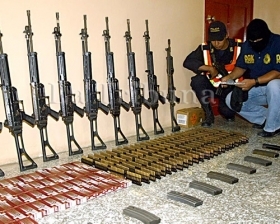Honduras is awash with weapons; a result of lax gun laws and a legacy of decades of civil conflict. The arms trade is flourishing in Central America and Honduras is at the center of this booming business.
A recent report released by the National Commissioner for Human Rights (CONADEH), in Honduras indicates that there are more than 850,000 weapons in circulation in the country. Only 258,000 weapons, however, are officially registered. It is therefore hardly surprising, in a country with hundreds of thousands of illegal weapons, that as many as 80 percent of homicides are firearm related.
Traditionally, Hondurans have taken a rather liberal approach to gun ownership, and each individual may register up five personal firearms. That is something which Ramon Custodio Lopez, President of the Committee for the Defense of Human Rights, has urged the country’s legislature to review. He has called for an immediate amendment to Honduras’s Law on the Control of Firearms and has demanded the creation of mechanisms to monitor the hundreds of thousands of illegal weapons in the country.
The so-called “Northern Triangle,” consisting of Honduras, Guatemala, and El Salvador is one of the deadliest regions of the world, outside active war zones. With a murder rate of over 77 per 100,000, more than five times higher than that of Iraq, Honduras is widely considered the region’s most dangerous country. The lack of control over gun ownership and the widespread availability of weapons are often cited as being among the principle factors behind the violence. Despite efforts to decommission the arms left over from Central America’s conflicts of the 1980s, many weapons evaded destruction during the 1990s peace processes and continue in circulation today.
Honduran weapons are not only fuelling violence within its own borders. Huge stockpiles of military weapons, often poorly guarded and controlled by corrupt officials are ending up in the hands of criminal gangs and drug cartels, operating throughout Central America and beyond.
Many are finding their way onto Mexico’s killing fields. In their escalating war against the Mexican authorities, drug cartels, in search of cheap, powerful weaponry, are now sourcing many of their weapons from stockpiles in Central America, according to a top US military official. “Over 50 percent of the military-type weapons that are flowing throughout the region have a large source between Central American stockpiles, if you will, left over from wars and conflicts in the past,” General Douglas Fraser, head of the U.S. Southern Command (Southcom), told a Senate hearing in April.
An investigation by Guatemala’s Attorney General found that the majority of weapons seized in Guatemala are sourced from Honduras. So many illegal weapons have been seized by Guatemalan police, reports La Prensa, that the Department of Arms Control can no longer hold any more in storage. In the space of just three months, the department has been forced to increase its storage capacity by 50 percent.
Honduran authorities have been accused of, at the very best, doing little to prevent Honduran arms flooding the region. At worst, however, Honduran authorities have been accused of facilitating the sale of weapons to criminal gangs. A confidential cable, written by former United States Secretary of State Condoleezza Rice to the U.S. Embassy in the Honduran capital Tegucigalpa in October 2008, and subsequently leaked by WikiLeaks, details the “possible unauthorized diversion, misuse or failure to secure” weapons supplied to Honduras by the U.S. The cable notes that light antitank weapons (LAWs) and grenades, supplied to Honduras as part of the U.S. Foreign Military Sales Program, were later recovered in Mexico and Colombia. Citing a report entitled “Honduras: Military Weapons Fuel Black Arms Market”, the cable suggests that military weaponry was made available to organized criminal groups by authorities during the administration of deposed president Manuel Zelaya.
Certainly, the widespread availability of weapons in Honduras can only partly explain country’s high murder rate and the country’s standing as the epicenter of Central America’s arms trade. But the reality remains that Mexican criminal gangs are finding in Honduras huge stockpiles of readily available, previously unused military-type weapons, as they increasingly expand their operations and move into other areas of Central America. As long as Honduras has lax gun laws, little control over its stockpiles of military weapons and deep institutional weaknesses, it will continue to be at the heart of Central America’s arms trade; a primary source of weapons fuelling violence in Mexico, throughout Central America and further afield.

